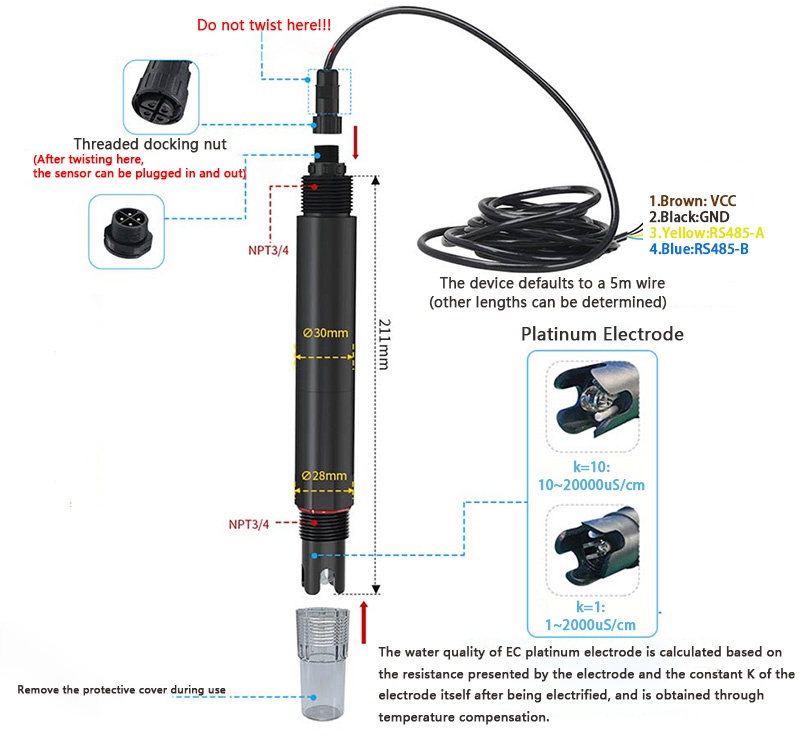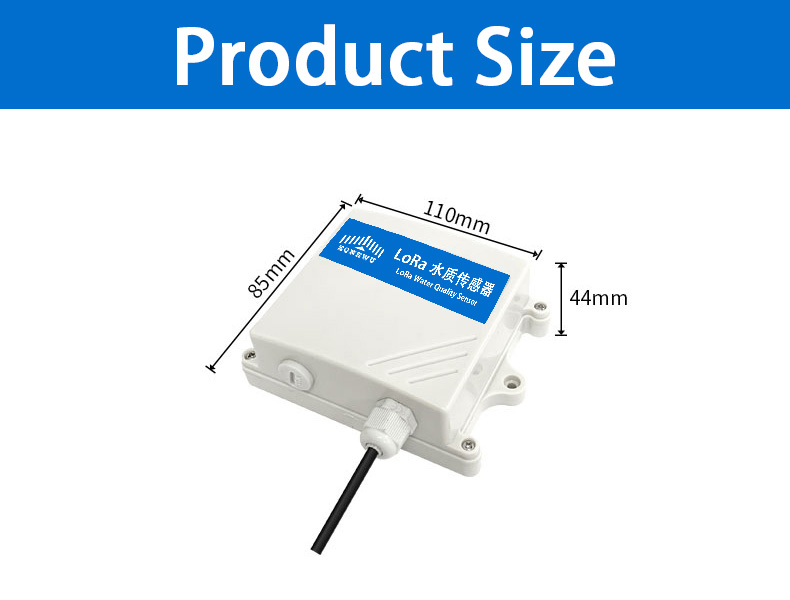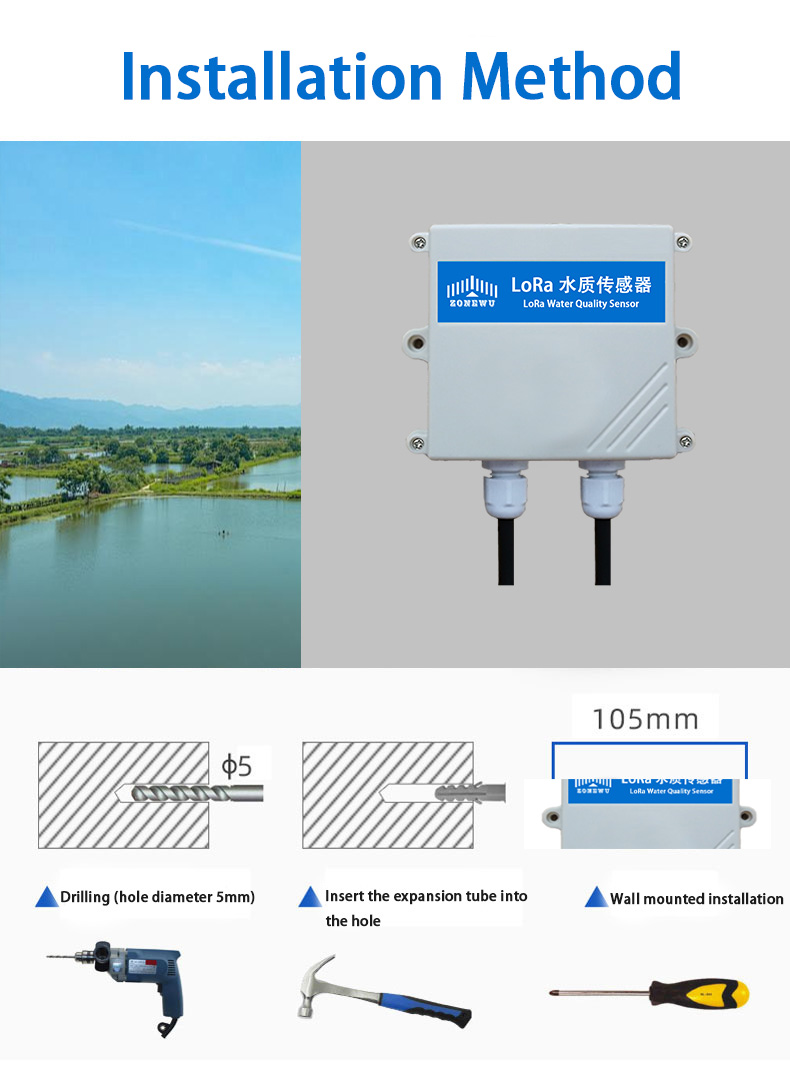Xiamen ZoneWu LoRaWAN Water Quality Electrical Conductivity Sensor is a multifunctional sensor used for measuring the conductivity, temperature, salinity, and TDS of aqueous solutions. A multifunctional wireless water quality conductivity sensor that integrates data collection, monitoring, and transmission. Equipped with automatic temperature compensation function, it can compensate the current temperature conductivity to the specified temperature, with good stability and reliability.
Product Model :
LW100-ECPower Supply Mode :
Battery or External DCFrequency :
CN470/IN865/EU868/RU864/US915/AU915/ KR920/AS923-1&2&3&4MAC Version :
LoRaWAN 1.0.3Mode :
OTAA Class A/CWeight :
200gMultifunctional Water Quality Electrical Conductivity Sensor
Xiamen ZoneWu LoRaWAN water quality conductivity sensor is a new type of IoT wireless sensor that integrates a LoRaWAN acquisition unit and a water quality conductivity transmitter.
Xiamen ZoneWu LoRaWAN water quality conductivity sensor Features:
This LoRaWAN collector and water conductivity sensor uses a lightweight aviation plug that is easy to connect and disconnect while also maintaining a compact setup.
The sensor automatically adjusts its readings based on temperature, so you get accurate conductivity data no matter what the conditions.
With standard LoRaWAN support, the collector ensures strong, long-range signal transmission - perfect for remote monitoring.
It is suitable for a variety of water quality monitoring scenarios, from rivers and fish farms to wastewater treatment, environmental inspections, and even food, pharmaceutical or drinking water applications.
Designed for industrial use, the ZoneWu LoRaWAN water quality conductivity sensor is designed to handle harsh environments and operate reliably, and can also monitor for long periods of time without problems.
Setup is very simple - just connect the wires, turn on the power, and start using, saving time and hassle.
Technical Parameters
| Power Supply | ER26500 Li-SOCl2 8500 mAh battery,3.6V | |
| Weight | 200g | |
| Operating emperature | -20~+80°C | |
| Sensor parameters | Temperature | -5~+80°C |
| EC |
Electrode constant K=1:1~2000us/cm Electrode constant K=10:10~20000us/cm |
|
| Salinity |
Electrode constant K=1:0~1000mg/L Electrode constant K=10:0~11476mg/L |
|
| TDS |
Electrode constant K=1:0~1100mg/L Electrode constant K=10:0~13400mg/L |
|
| Typical Accuracy | Temperature | ±0.1℃ |
| EC |
Electrode constant K=1:0.1 μ s/cm; Electrode constant K=10:1 us/cm; |
|
| Salinity | - | |
| Temperature Compensation Range | -5~+80℃ (default compensation temperature is 25℃) | |
|
Temperature Compensation Coefficient |
Default 0.02 |
|
|
EC Equipment Working Conditions |
-20~+80℃ |
|
|
Pressure Resistance |
0.6MPa |
|
|
EC Transmitter Line length |
Default 5m (other lengths can be customized) |
|
|
Frequency |
CN470/IN865/EU868/RU864/US915/AU915/ KR920/AS923-1&2&3&4 |
|
|
Mode |
OTAA Class A |
|
|
Reporting cycle |
60min(Default ) |
|
|
Battery Life |
≤3 years (Depending on the reporting cycle) Note: Due to the high power consumption of EC sensor, it is not recommended to use short cycle data reporting. |
|
|
Communication Protocol |
LoRaWAN,LoRa TDMA Networking |
|
|
Equipment information (Reference) |
AppEUI:0000000000000001 DevEUI:aaaa202404150001 AppKey:00001111222233334444555566667777 MAC Version:LoRaWAN 1.0.3
|
|

EC Transmitter Size and Installation
1. Submerged installation: The lead wire of the equipment is passed through the waterproof pipe, and the 3/4 thread on the top of the equipment is connected with the 3/4 thread of the waterproof pipe with raw material tape. Make sure that the top of the equipment and the equipment lines are free of water.
2. Pipe Installation: Connect to the pipe through the 3/4 thread of the device.


Common knowledge of conductivity EC
What is conductivity
Water quality conductivity is the ability of water to "conduct electricity". The smaller the value, the purer the water. It's just like measuring the conductivity of an electric wire, except that it measures water.
Why does the value change?
Pure water has a very low conductivity. Pure water is almost non-conductive (the value is super low), but if salt, acid, alkali and other "seasonings" are added to the water, the value will go up. The more charged impurities in the water, the higher the value.
Temperature has a great influence
Conductivity changes with temperature. For every 1 degree increase in water temperature, the value increases by about 2% (the value measured in summer will be higher than that in winter). So everyone defaults to measuring at 25℃, which is easier to compare.
Ultrapure water is also afraid of being put in
The conductivity of freshly made distilled water is very low (0.5-2uS/cm), but after a while it will absorb "dirty things" in the air (such as carbon dioxide), and the value will slowly rise to 2-4us/cm
Common water comparison
The conductivity of drinking water is between 50-1500US/cm (it is normal to have minerals); the conductivity of seawater directly soars to 30000US/cm (after all, it is extremely salty); the conductivity of clean river water is 100us/cm (cleaner than tap water).
Why Choose ZONEWU